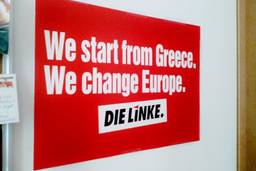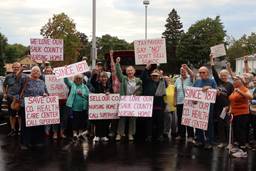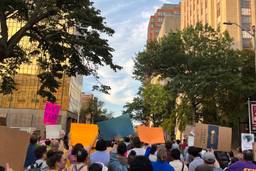How Black Lives Matter Has Spread Into a Global Movement to End Racist Policing
The next Baltimore could be somewhere in Europe.
Amien Essif

When Baltimore erupted into protest this April over Freddie Gray’s death, it was clear that the movement against racist police brutality that began last August in Ferguson, Missouri, had survived the winter. Baltimore, many said, was the next Ferguson.
But where, then, is the next Baltimore? Perhaps somewhere in Europe.
On May 18, hundreds of Parisians gathered to protest the acquittal of two police officers who, in 2005, allegedly did nothing to prevent the accidental electrocution death of two teenagers— one black, one of Arab descent — who had run into an off-limits power facility while being pursued by police.
“I’m disgusted,” the brother of one of the boys said exiting the courthouse. “The police are untouchable.”
At a May demonstration in London, the name on picket signs was Julian Cole, a 21-year-old black Briton who has been in a vegetative state since 2013, when police allegedly left him with spinal injuries uncannily similar to those suffered by Gray in the back of a police van.
At Berlin’s May Day parade, activists with Berlin’s Ferguson Is Everywhere campaign distributed signs emblazoned with the names of Christy Schwundeck, Dominique Kouamadio and Oury Jalloh—people of color killed by German police in the past 10 years.
The slogans that have defined the U.S. protests have crossed the Atlantic: “Hands Up, Don’t Shoot” and “Black Lives Matter” are common chants. At a November 2014 protest in Amsterdam, a young black man being violently subdued by police gasped, “Ik kan niet ademen,” Dutch for “I can’t breathe” — echoing Eric Garner’s last words.
The Black Lives Matter movement has sparked solidarity actions around the world, from São Paulo to Delhi. But in Europe, actions have been particularly frequent, insistently drawing attention to the plight of black minority populations policed by majority-white forces.
“We face the same problems, just in a different place,” says Jessica de Abreu, board member of the New Urban Collective in Amsterdam, pointing to the Netherlands’ history of slavery and colonialism as the common bond between African Americans and Afro-Dutch.
The Netherlands, like France, England, Italy, Spain, Portugal, Belgium and Germany, were instrumental in the transatlantic slave trade and maintained colonies in Africa well into the 20th century. Historically, waves of migration from Africa have been closely bound up with slavery and colonialism, from the some 200,000 slaves brought to Europe between the 15th and 19th centuries, to the thousands of North Africans invited to France to fight in WWII and to rebuild after the war.
Since the turn of the 21st century, hundreds of thousands of migrants from North Africa — and, increasingly, West Africa — have flooded into Southern and Western Europe, fleeing famine, drought and conflict. Many live undocumented, and that, combined with the refusal of countries such as France and Spain to track ethnicity, makes the size of Europe’s total black population difficult to estimate. It may be more than 8 million.
What’s clear, according to a June 2012 briefing paper from the UK Race and Europe Network, is that racist stereotypes about skin color are prevalent in Europe, and “anecdotal and country-specific evidence shows that people of African descent are consistently and disproportionately discriminated against” in everything from housing to employment. That includes policing: Blacks are six times more likely than whites to be stopped by Paris police, for example, and in a 2010 survey, Sub-Saharan Africans in Spain were by far the most likely group to report having had police check their IDs in the street.
It’s not hard to see why the Black Lives Matter movement resonates. Since August 2014 there have been regular actions not only in Paris and London — European capitals with large and impoverished black populations — but also in cities with smaller black minorities, such as Amsterdam and Berlin.
According to organizers from London, Paris, Berlin and Amsterdam who spoke with In These Times, European solidarity with Black Lives Matter goes beyond sympathy for black Americans. Rather, it is part of a movement to end racist policing in Europe.
This may come as a surprise to those who point to European police as role models for their U.S. counterparts. Business Insider, for example, has called the rate of police killings in the United States “alarming” in contrast to the rest of the developed world, citing the FBI’s conservative estimate that 404 people were killed by police in the United States in 2011, compared to 14 in Australia, Great Britain and Germany combined. The British Economist noted proudly that “even after adjusting for the smaller size of Britain’s population, British citizens are around 100 times less likely to be shot by a police officer than Americans,” attributing the vast discrepancy to the fact that British police officers — often fondly caricatured as whistle-blowing, truncheon-twirling bobbies — aren’t “hyper-militarized” like their U.S. counterparts.
Black activists in Europe, however, tell a different story. “The British bobby is a stereotype that hardly if ever existed for Africans and African Caribbeans living in the UK,” says Kojo Kyerewaa, coordinator of the London Campaign Against Police and State Violence (LCAPSV), in an email to In These Times. “Police in Britain may not carry firearms as standard issue, [but] they have shot and killed unarmed black people.”
Kyerewaa cites the shooting death of Mark Duggan in 2011 and the devastating injury to Julian Cole in 2013 as just the most high-profile examples of the bobby brutality against people of color, noting that, unlike in the US, no British police officer who killed a civilian in the line of duty has ever been sentenced. He also points out that Great Britain imprisons black people in even greater disproportion to their share of the general population than the United States, according to a new report from the Equality and Human Rights Commission.
“We do not think that the British model of policing is anything to aspire to,” says Kyerewaa. “It may produce less deaths, but our aspiration should be the abolition of racialized state-sanctioned murder, not merely the reduction of its pace.”
In December, after Garner’s death, LCAPSV helped organize an occupation of a shopping mall in a London suburb. About 600 protesters participated and 76 were arrested, according to Newsweek.
Dutch anti-racist organizer Jessica de Abreu believes the difference in rates of police violence across the Atlantic should not distract from the common experiences of people of color in majority white countries. “In the Netherlands, you don’t have this massive murder,” she says. But “as Europeans — especially in the Netherlands — we like to hide behind this image of being liberal and tolerant, which we definitely are not. And if you talk about racism, you’re silenced.”
“We’re frustrated because this is not specific to the North American context — it’s just that it’s a lot more shushed in the German context when things like this happen,” says Jamie Schearer, founder of the Berlin-based European Network of People of African Descent. She attributes the invisibility of racist police violence in Germany in part to a smaller and poorly networked black community. Whereas “the U.S. has a long tradition of civil rights organizations and institutions,” she says, Germany does not.
But the acceleration of anti-racist organizing in the United States in the past few years has given European campaigns like hers a boost, she says. Schearer and her fellow German activists launched a campaign against racial profiling in the wake of the 2012 killing of Trayvon Martin, marching in hooded sweatshirts in solidarity. Since Ferguson and Baltimore, there has finally begun to be a “discourse around racial profiling” in her country.
The predicament of black people in Europe is distinct from that of black Americans in at least one regard: It’s inseparable from the experience of Muslims and immigrants. In the low-income housing projects on the outskirts of France’s larger cities, for example, black people live side by side with first- or second-generation Muslim immigrants from North Africa. More than 50 years after Algeria became France’s last major colony to win independence, many of the country’s black and Arab residents feel that little has changed in the relationship between the country’s white and nonwhite population. And throughout Europe, hate groups target Arabs and black Europeans alike, as well as Roma and Jews. Because of this, the Black Lives Matter banner has been picked up by umbrella anti-racist groups like the French Party of the Indigenous of the Republic (PIR).
No one can say when or where the next act of police violence will trigger unrest, but the European activists who spoke to In These Times are not waiting around to find out. Both Schearer and de Abreu are collaborating with Opal Tometi, co-founder of the U.S. organization Black Lives Matter, to build a stronger transatlantic alliance. In Paris, PIR held a 10-year anniversary celebration in May with American activist Angela Davis as a guest speaker, and, at the behest of the sister of Amine Bentounsi — a 29-year-old man from a Moroccan family killed by French police in 2013 — is helping organize a march against racism on October 31.
When asked if PIR would continue to make connections to the struggles in Ferguson and Baltimore, organizer Mehdi Meftah sounds surprised at the question. “We always make the connection, in all of our actions,” he says. “Whether it’s the United States, Germany, Great Britain, France — it doesn’t matter. The connection is obvious.”








